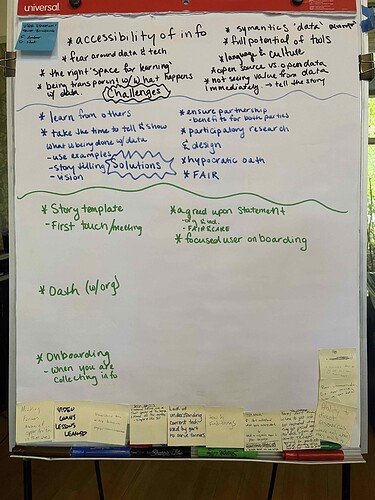Participants: @AmberS , Dorn, @tysonwynne, @courtney.king , @mushi-shi , @JeffPiestrak, @Elhenriq , @nat
Current Challenges
- Lack of accessible information
- Fear – people see “data” and the mind goes to information being compromised in some way
- Need education for the full potential of digital tools – tech often introduce many functions and features, but users often only use a tool for their specific purpose
- Creating space for learning (language, culture, and acronyms)
- Tech conversations often use a lot of acronyms, making these conversations inaccessible to users
- Need to create trust for learning by first setting the space to be open to questions
- Different people have different learning styles (synchronous or asynchronous, digital or in person, good moderation, etc.)
- Distrust in tech
- Open source vs open data
- Tension between private enterprise and a shared benefit of public data
Agriculture manages private enterprise, but the whole group can benefit from shared data
- Tension between private enterprise and a shared benefit of public data
- Open source vs open data
- Need to be transparent with what happens with data
- If not seeing value from a tool immediately, users start to question who is getting value (is someone else benefiting from a user’s data input?)
- Language around the big picture, storytelling, and the language used is at the crux of this challenge
Possible Solutions
- Learn from each other (within GOAT community and beyond)
- Build trust with farmers through complete honesty
- What information is being collected, who is it going to, and what will be done with the data
- Show the farmers what will be done and the benefit they will get (showing instead of just telling builds trust)
- Need to engage in storytelling / larger narrative (vision) to provide the context, before trying to get the community to engage
- Cannot just ask people to trust us without a clear intention and expectation for the benefits and outcomes
- Name recognition within a community can help build trust (example: signs on the fields)
- Participatory design – make everybody a stakeholder, so everyone has a say and all design decisions are made through consensus (a type of human-centered design)
- Ensure partnerships benefit both parties
- Before getting someone to commit to the process, need to see it’s worth their time
- Hippocratic oath
- Important for storytelling – who are you, why are you here, what do you believe in, etc.
- Shows that you’re being held accountable
Next Steps
- GOAT training on participatory design
- Documentation
- Core elements of a story template (these are the things that should always go to users at the get-go)
- Who you are, what you want from them, and show examples of what the outcome will be
- Hippocratic oath template (agreed upon statement of trust)
- There’s an organizational statement and an individual statement
- Core elements of a story template (these are the things that should always go to users at the get-go)
- Need to find a balance between focused (individual) user onboarding and documentation or group onboarding calls
- User Journey! (what do we need for storytelling (1st meeting / engagement), oath (parallel trusted agreement), and onboarding (have commitment, now what?)
- See some of the core elements in our brainstorming (attached, sorry for the low quality).
- See some of the core elements in our brainstorming (attached, sorry for the low quality).

